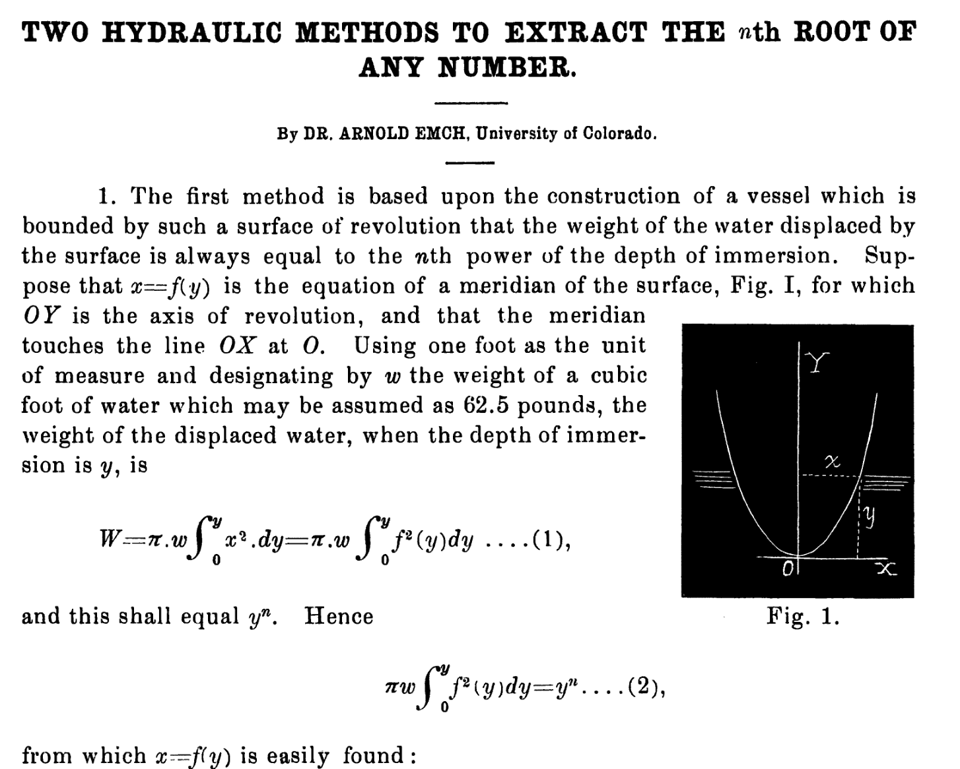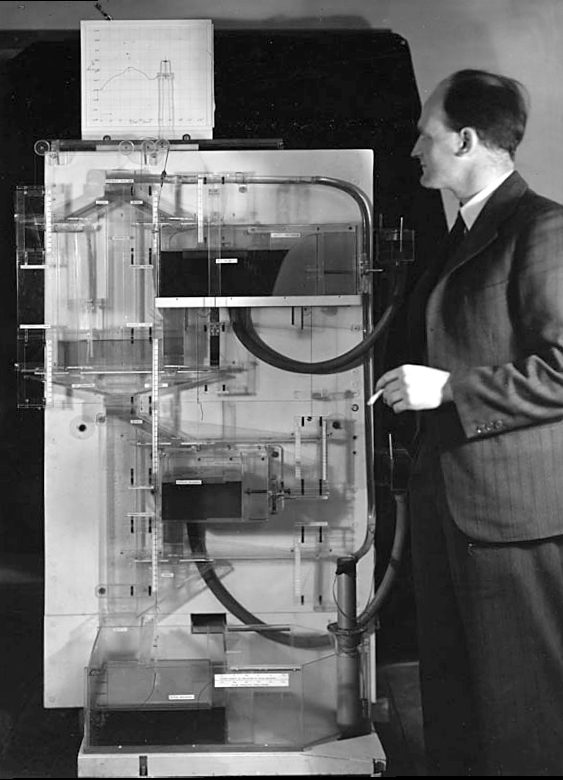Much as I’ve heard over years about water memory, I’ve also heard whispers about “water computers.”
Before computers as we know them today went electronic, there were machines doing computation in a variety of analog ways. Analog computing just means some mechanical activity to do the computing: doing addition with pencil on paper is analog computing. We can make machines that automate this process, ranging from an abacus (still analog) to GPUs (if we go electronic). The Inca did it with quipu. What exactly “computation” means is honestly up for debate: transforming states/values in structured ways? Data getting reworked? But let’s sidestep that for now. Information goes in (two and three), computation happens (plus), information comes out (five).
As I learned in this great history of liquid computing (2019) by Andrew Adamatzky, a nifty technique for factoring was published in 1901:

Making clever use of water's well-behaved nature and some mathematics, the author got the water (and a little contraption) to compute for him something that would be much more difficult to do by hand. This kind of tool-based thinking escalated: people in the mid-20th century made systems of reservoirs and pipes to simulate dynamic systems and perform computation. Calculation "with plumbing." These efforts include the MONIAC and the Russian Water Integrators.
 The Computer That Ran On Water
The Computer That Ran On Water
In these machines, the calculations were governed by fluid moving through carefully-designed geometries, making them purpose-built and not very generalized:
All the prototypes have only one thing in common: they use liquid to encode and process information. The exact implementations of the computing devices are very different one from another.
This "computation" is matter moving around and responding to the laws of physics. It's crucial that pushing on water somewhere immediately sends shockwaves of pressure through the system, at the speed of sound, allowing information to travel through the medium. In its infancy, electricity was imagined as a fluid "flowing" through metals, and to this point, a lot of electronic-hydraulic analogies hold surprisingly well. (They also do fail at a certain point, though.)
To overcome the purpose-built water computers thus far, new techniques were invented called "fluidics," where logical functions like AND, OR, and XOR could be created by jets of water with different pressures interacting. Now, essentially, we have transistor behavior as water moves through a system of tiny tubes:
Equipped with logic gates, fluidic computers could handle a lot more computation. Hydraulic circuits have shrunk in size and become more sophisticated, and are now used in various microfluidics contexts, particularly microbiology. In small wet crevices inside organisms or wet-lab experiments, electronic components would more likely fail, but fluidics help compute for biological or chemical experiments.
In a dizzying next step, the computation of fluidics broke out of its tightly designed hydrauic circuitry with the concept of "collision computation" or "billiard-ball computation." Here, the presence of a droplet—or other property of a fluid, or even waves propagating through fluid—at a given location indicates True, and absence False. Information whizzes around and collides like marbles in some spatial area, thereby enacting computation across a domain of data.
 Wacky figure from Adamatzky's History
Wacky figure from Adamatzky's History
Collision computation brings us closer to computation happening out "in the world" rather than in an explicitly-designed component like an integrated circuit. There are some big leaps necessary to take these abstract models of computation into the messiness of the real world, especially an open system like the outdoor environment, but can computation happen in a flow of water molecules moving across the earth?
My motivation for writing here actually came from discovering an announcement from 2021 that some mathematicians proved you can make a Universal Turing Machine "out of water"—put another way, we can enact any algorithm by following a particle along its trajectory in the 3D Navier-Stokes equations, which govern fluid motion. This is all abstract, but it brings together hydrodynamics with the capacity to perform computation. An update by the same authors in March 2025 titled "Towards a Fluid Computer" builds on this.
Despite my love for Navier-Stokes, the math in these publications is over my head. I'm more excited by the conceptual perspective shift that water "does" computation. As a hydrodynamicist and geomorphologist, I'm constantly thinking about how water figures its way through landscapes, responding to conditions and rearranging its playing field—computing, I guess.
I've watched the tides and waves come in and move around a marsh. But what is the water computing?
I think we could say it is computing its own evolution, or the change of the system: every moment computes the state of the next. Or in a Lagrangian dynamics sense, the system is figuring out the trajectory of stationary action. (Man, I miss some of that math!) Computationally, the system is just taking in what it receives and figuring out what to do next.
The magic of an actual "water computer" is in replacing a circuitry-filled and logic-driven device, programmed to simulate something in the constraints of computer architecture, with letting physics in the real world do the work for us. Adamatzky and his Unconventional Computing Lab at University of the West of England have actually done this with a colloidal suspension!!!
 See Achieving liquid processors by colloidal suspensions for reservoir computing
See Achieving liquid processors by colloidal suspensions for reservoir computing
If I understand this right, the colloidal particles bounce around the reservoir and perform collision computation (-ish), essentially simulating a sparse neural network.
 Very similar figure, not actually relevant to the paper, from the Wikipedia Page on Echo State Networks
Very similar figure, not actually relevant to the paper, from the Wikipedia Page on Echo State Networks
At this point, the direction of the work starts to blur to me. Are we trying to force liquid to behave like an electronic computer? Or are we starting to understand the information encodings inherent in hydrodynamics? It all rapidly becomes more animistic, more philosophical. Perhaps the world is always "computing"—and, if so, environmental scientists need to be articulate about the importance of simulating, and the nature of our simulations. Are we adding anything with our additional computing? Or is it just computing for the sake of computing like in proof-of-work?
I must also admit to be inspired by two initiatives by friends: AWS runs River Computer (connecting ecological systems to social technology—and giving a talk in San Francisco Dec 1!) and Éd runs Flower Computer (with a cool animistic app for interacting with the world, Yuma).
Three fun links I couldn't find homes for:
- More thoughts on logic in a water-computer.
- "Amorphous Computing" at MIT in 2000.
- Deltar, the analog computer for simulating the Dutch Delta Works. Thanks Lorentz!!!
Computing,
Lukas
P.S. Wow, Gnamma is one hundred editions old. Thanks for reading and supporting my little amphibious garden of ideas, everyone.
You just read issue #100 of Gnamma. You can also browse the full archives of this newsletter.


